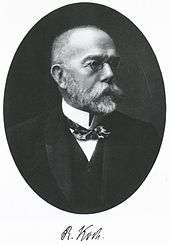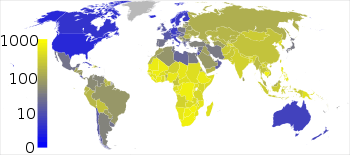National Tuberculosis Institute
| Established | 1959 |
|---|---|
Officer in charge | Dr. Prahlad Kumar (Director) |
| Location |
Bangalore, Karnataka, India 13°0′6″N 77°34′58″E / 13.00167°N 77.58278°E |
| Nickname | NTIB |
| Website | Official Web Site |
 | |
| Bengaluru Landmarks | |
The National Tuberculosis Institute (acronym NTIB)[1] is a Government of India institute, under the Directorate General of Health Services, Ministry of Health and Family Welfare, dedicated to advanced research on Tuberculosis. The Institute is located along Bellary Road, in Bengaluru, Karnataka state, India.
Profile

The National Tuberculosis Institute owes its origin to the findings of a 1955-58 survey conducted by the Indian Council of Medical Research (ICMR) where high incidence of pulmonary tuberculosis was found across the country. Acting on the survey findings, the Government of India initiated actions to start an advanced research institute solely dedicated to the cause and, as a result, NTIB was established in 1959, on a property, Avalon, donated by the then Maharajah of Mysore. The technical assistance was provided by the World Health Organization and the Institute procured the equipment through UNICEF assistance.
The Institute has, ever since, been active in research projects and studies and has been successful in formulating a TB Control Program for the country which incorporates the clinical, epidemiological and sociological aspects of the disease. It is involved in activities such as training of medical and paramedical staff and personnel across the country, formulating policies and programs in accordance with the WHO recommended DOTS strategies, planning, coordinating and executing research on the disease and its epidemiology, monitoring of programs, campaigns and impacts and documentation and dissemination of knowledge through print and audio-visual media.
The Institute was accredited as a WHO Collaborating Centre for TB research and training in 1985.
Programs
Training programs
The primary activity of the Training Department of the Institute is to train the medical and paramedical personnel, both as career-based and in-service courses, to groom them for training the staff working at the primary health centres and other lower strata medical facilities in the country. The course, Training of Trainers (TOT), is a two-week course, open to medical and paramedical personnel in the District Medical Centres and medical colleges.[3]
The other training courses offered by the Institute are:
- State TB Training and Demonstration Centre (STDC)[4] Training: Three week course for STDC personnel such as Epidemiologists, Bacteriologists, Statisticians, TB specialists and trainers.
- RNTCP Modular Training: The course is designed as modular and is aimed at Senior Treatment Supervisors (STS) and Senior TB Laboratory Supervisors (STLS) and other training officers of the District Medical Centres.
- Training for Program Managers: Two week program for the Senior TB Officers (STO) and the Medical Officers (MO) aimed at developing the managerial and computer skills.
- Post graduate Training: 10-day program for the master's degree students in Community Medicine, Chest Medicine and General Medicine and the mode of training is through practicals and presentations.
- Training for NGOs and Private Practitioners: Two day course for private practitioners and NGOs as per recommendations from the State or Central TB Divisions.
- Training of WHO Fellows: This is a special program for WHO Fellows and is conducted on request and recommendation from WHO.
NTIB also conducts regular seminars, workshops and conference for easy dissemination of knowledge and information.[3]
Research programs

NTIB undertakes research programs on a regular basis, two of the current programs are:
Capture-recapture to estimate incidence, periodic prevalence and completeness of Tuberculosis cases reporting under RNTCP in Tumkur district: The program aims to estimate the incidence and period prevalence of the disease in Tumkur district in Karnataka and arrive at the case finding efficiency of the Revised National Tuberculosis Control Program (RNTCP).[6] The research methodology is based on capture-recapture method where the patient record is compared with various other data sources.
Challenges in implementation of diagnostic algorithm for patients having symptoms suggestive of pulmonary TB with smear negative report initial sputum examination: The project is focussed on preparing a database of smear test negative patients under RNTCP in the districts of Mysore, Mandya, Chikkamangalur and Shimoga, chart out the system and patient constraints and to document the behavioural patterns of the patients for preparing a diagnostic algorithm. The methodology deployed is random sampling and interview and comparison of the data with the lab registers maintained at the District Medical Centres (DMCs).
Monitoring programs
The monitoring program of NTIB covers the whole of India except the Union Territories of Daman and Diu and Lakshadweep under National Tuberculosis Programme (NTP) and Revised National Tuberculosis Programme (RNTCP). The program covers monitoring of data of smear positive and Smear negative case detections, sputum positive cases and treatment success rate.
Library
NTIB Library, established in 1960, is the knowledge repository of the Institute and acts as the Information Support Centre of the Institute and oversees the publications and the dissemination of information. It is accessible to the faculty and staff of the Institute, trainees, medical students, research scholars, health care providers, patients and public. The Library stocks 4,000 reference books and 10,000 bound volumes on Tuberculosis related topics such as Public Health, Radiology, Bacteriology, Statistics, Sociology, Epidemiology, Fugitive and Grey literature. It subscribes to 20 international and 35 national periodicals and has a collection of 120 audiovisual packages, 700 slides, 30 CDs and 150 transparencies, other than the NTIB publications.
Publications
NTIB has published many books, leaflets and journals related to Tuberculosis and its control mechanisms.[7]
- Shashidhara AN (1980). An introduction to tuberculin testing and BCG vaccination. IBH Prakashana.
- Krishna Murthy VV (1991). Facts and figures on tuberculosis and National Tuberculosis Programme. TNIB.
- Krishna Murthy MS & Shashidhara AN (1992). A manual for tuberculin testers and readers. TNIB.
- Shashidhara AN & Chaudhuri K (1990). Tuberculin skin test - emerging 100 years since its first use. TNIB.
- Mahadev B & Balasangameshwara VH (1995). What you should know about tuberculosis – Its diagnosis, treatment and prevention. TNIB.
- Balasangameshwara VH; Sujatha Chandrasekaran; Sophia Vijay; Suryanarayana L (1995). TB & HIV. TNIB.
- TNIB (1996). Guidelines for laboratory procedures in tuberculosis – a chart. TNIB.
- Jagota P & Srikantaramu N (1997). Summaries of NTI studies. TNIB.
- Suryanarayana HV & Chadha VK (1998). Childhood Tuberculosis. TNIB.
- Chauhan MM; Mahadev B & Balasangameshwara VH (1998). Manual on isolation, identification and sensitivity testing of Mycobacterium tuberculosis. TNIB.
NTIB has also brought out several manuals, guides and other publications.
- Manual for Census Takers - 1960
- Manual for the BCG Vaccinator - 1960
- Manuals for the key personnel of District Tuberculosis Programme viz., Introduction, District Tuberculosis Officers, Treatment Organisers, Statistical Assistants, X ray Technicians and Peripheral Health Institutions - 1963
- Periodical Abstract Bulletin (for internal circulation only) - introduced from the year 1967
- Summaries of NTI studies Vol I & II 1976 & 1977
- Summaries of Tuberculosis Research Centre studies Vol I & II 1976 & 1977
- Report of the WHO-Government of India Workshop on Tuberculosis and Primary Health Care - 1981
- Establishment and functioning of a Tuberculosis Culture Laboratory - 1983
- NTI Souvenir - 1985
- Proceedings of the NTI Silver Jubilee Celebrations - 1985
- Tuberculosis: its diagnosis and treatment for lay persons - 1985
- Participation of General Medical Practitioners - a key to success of National Tuberculosis Programme - 1985
- Scientific Report 1980-89 - 1990
- Guidelines for Medical Officers of Peripheral Health Institutions on National Tuberculosis Programme – Chart - 1990
- Introduction to District Tuberculosis Programme - 1994
- Manual for District Tuberculosis Officers - 1994
- Manual for Treatment Organisers - 1994
- Manual for Laboratory Technicians - 1994
- Manual for Statistical Assistants - 1994
- Manual for X-ray Technicians - 1994
- Manual for Peripheral Health Institutions - 1994
See also
References
- ↑ "acronym". Retrieved July 14, 2014.
- ↑ "TB". web site. Medical Dictionary. 2014. Retrieved July 16, 2014.
- 1 2 "Training" (PDF). PDF. Retrieved July 16, 2014.
- ↑ "STDC". Retrieved July 16, 2014.
- ↑ World Health Organization (2009). "The Stop TB Strategy, case reports, treatment outcomes and estimates of TB burden". Global tuberculosis control: epidemiology, strategy, financing. pp. 187–300. ISBN 978-92-4-156380-2. Retrieved 14 November 2009.
- ↑ "RNTCP". Retrieved July 15, 2014.
- ↑ "Publications". Government of India. Retrieved July 16, 2014.
External links
- http://www.tbcindia.nic.in/rntcp.html
- on Wikimapia
- Reference on TB Association of India site
- Reference on US National Library of Medicine, National Institutes of Health site
- Reference on Indian Journal of Medical Ethics